Thiess is one of the largest global surface mining services companies today, with fast growing businesses in metals and minerals, rehabilitation, technology and technical services. The term mining services is deliberate – because it is no longer enough to describe Thiess as a contractor, with many of its client relationships equating to long term alliances. Plus, Thiess’ role usually goes way beyond load and haul – its remit can and does include everything from mine planning through to rehabilitation. On the technology side, Thiess is one of the most experienced integrators of autonomous haulage and drilling technology – both with the established OEM offerings but also the new and upcoming open autonomy offerings. Its fleet size is larger than some of the mining companies it works for. That, and the fact that Thiess is OEM-agnostic, and the global nature of its activities, give it a uniquely important place in helping the mining industry reach its net zero targets across everything from battery and hybrid trucks to trolley assist and IPCC. IM Editorial Director Paul Moore sat down with Michael Wright (pictured), the Executive Chair and CEO, at the November 2022 IMARC event in Sydney– to talk through the company’s reach and capabilities, and how it is helping to build the mine of the future today.
Thiess working with WesTrac successfully rolled out a system that involves three Caterpillar drill rigs being remotely operated by a single operator
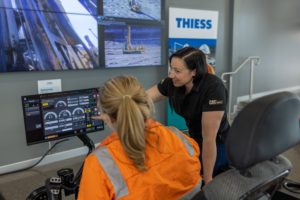
How would you summarise the scope of the Thiess offering to today’s mining industry?
MW: We are a truly global mining services provider. That means we do everything from turnkey mining, where we undertake mine planning, development and resource modelling, through to mine work execution including equipment supply, equipment operation, right through to loading the commodity onto trains to the client’s specification. We also handle other requirements such as capacity expansions and mine rehabilitation, for which we recently established our standalone Thiess Rehabilitation business. We also have technology and technical services capability in-house and are looking at how we can commercialise that into a client offering. In fact, we just signed a deal with Tata Steel to help them plan and run their mines more efficiently, and as well as jointly pursuing technologies that we can together offer to the mining industry. We’ve got 15,000 people in seven countries, with over 2,000 units of large mining equipment, which includes over 1,200 haul trucks with a payload of over 100 t. So, we have strong asset management and maintenance capability, with a fleet size larger than many of the mining customers we work with.
Liebherr T 264 operated by Thiess in Chile
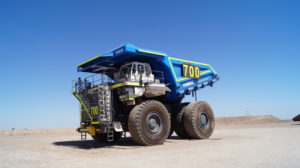
You are best known for your operations in Australia and Indonesia – how are you growing your business in other major mining hubs?
MW: Towards the end of 2021, we expanded our operations into the North American market, based on a clear strategy to diversify our commodities and services aligned with ensuring Thiess is at the forefront of sustainable mining. We established a new office in Salt Lake City and secured our first mining operation at a hard rock operation in Colorado. The mining works began as a mining services contract but after a year has already evolved into a relationship based alliance style contract – where the client sees it as an opportunity to work together to drive mine efficiency and safety, and introduce contemporary mining practices and the latest technology into their operations. We are pleased to have recently secured a further two-year extension to this mining partnership.
We expanded into Chile in 2015 with Antofagasta Minerals (AMSA) at their Encuentro Oxides project, which forms part of the Centinela copper operation. Since then, we’ve continued expanding our service offering working with various clients in copper in Chile. We still return to AMSA as an important client of ours and one that is very open to working with us on advancing mining efficiency and sustainability through partnership.
And while well established in Australia and Indonesia, we continue to grow and diversify our business in those countries, through new contracts and new services, as well as extending very long term relationships. To give a few examples, in June 2022 we were awarded a life-of-mine contract to provide mining, rehabilitation and port management services by PT Kapuas Tunggal Persada and PT Tempirai Inti Energi in Central Kalimantan, Indonesia. In August, Rex Minerals notified us of their intention to enter into exclusive negotiations to finalise the terms of a long term mining contract at their greenfields mine in South Australia. Subject to a contract being concluded, Thiess is expected to deliver mining services and help position this greenfield copper operation at the cutting edge of sustainable mining. Earlier in 2022, we were also appointed mining services provider for Fortescue Metals Group’s new Iron Bridge Project in Western Australia. Under the initial three-year contract, Thiess will deliver mining and maintenance services and asset management services, working with Fortescue and other external stakeholders at this showcase mining operation.
Thiess is delivering mining services at FMG’s new Iron Bridge project in WA
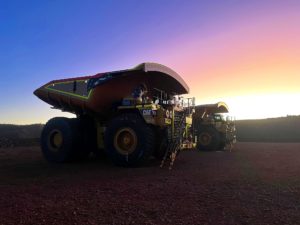
Has your underlying strategy in services provision evolved and changed as well? Does that include bringing the latest technologies to customers to help them achieve their goals, including autonomy?
MW: We set in motion a new strategy about 18 months ago, which is focused squarely on sustainable mining and how we can align our activities with the future of mining and the energy transition. From a technology perspective we started some years ago in Western Australia, where we helped Fortescue take the Solomon Hub to a fully autonomous fleet operation. We worked with them to build and run the mine, and then worked closely with Fortescue and Caterpillar to integrate the Command for hauling technology and transition the operations over time. That success led to us working again with Fortescue at their Chichester Hub Christmas Creek operation on a large autonomous retrofit program. We then continued to be involved with asset management at Solomon over many years, including providing the technical upgrades.
And we’ve continued our focus on autonomy and technology since then. On the east coast of Australia, we have autonomous drills running at two sites – at the Lake Vermont mine in Central Queensland, working with Epiroc Pit Viper drills; and at the Mount Pleasant mine in NSW, working with Caterpillar MD-series drills. We are successfully proving these autonomous operations, and they are today running as part of the production fleets after successful trials. We also have six semi-autonomous dozers running, using Cat D11 machines operated from two side-by-side remote operator stations. From Caterpillar’s perspective, we are one of their most advanced users when it comes to drill and dozer automation globally, working with them to help develop their technology.
On the dozers, there is still a transition needed to get them to fully autonomous operation however progress is being made. We are also looking to bring that autonomous dozing capability into our Thiess Rehabilitation business as well. We are already using technology as a differentiator to reduce the volume of material movement for rehabilitation – using algorithms in the rehabilitation earthworks design that can be used directly by the autonomous dozers. This builds on the focus we have using operational data in our business to drive performance – driven by the fact that our revenue is based not on selling the mined commodity but from the performance and efficiency of our operations.
While global supply chains are somewhat challenging presently, we have very good and long term relationships with all the OEMs and global suppliers. That helps us in being able to source parts and equipment on a timely basis at the right cost base. We have very close and strong relationships with the Japanese trading companies, which dates all the way back to Thiess Peabody Mitsui Coal and the start of mining in the Bowen Basin in 1962, opening up the export of first coking coal to Japan. We are also close to Mitsubishi and Marubeni through their ownership in some of the mines in which we operate. These relationships are both from a client perspective, and also as long term partnerships. I can say we are working closely with two of the companies mentioned on potential JVs on mining technology. This would include developing technology not just for Thiess but also possibly for the wider global mining market.
How does your approach to autonomy from a cost advantage point of view differ to that of owner operator miners based on the fact you are normally working with fixed period contracts?
MW: On the back of our focus on operational delivery, technology and sustainability, we have secured the mining services contract for a greenfield coal mining project in Queensland, with operations set to start in 2023. We are initially signed up for eight years, which includes the planning and development of the mine, taking it into full production. This includes the implementation and operation of autonomous fleets for overburden haulage and drilling. We are designing and building all the necessary infrastructure, including the mine LTE network, which is a first for us at this level. We have a strong team of autonomy and technology experts, both office and field based, that have already been involved in deploying drills and dozers at our projects. The opportunity that we’ve got, and we are talking to other clients about this as well, is in helping them integrate autonomy into their operations – whether we are actually running the mine or not. We are providing autonomy integration as a way of helping them with their mining practices of the future – which change substantially when you go to autonomous mining. Making sure that transition is done safely, that the integration is seamless, and that production outcomes are optimised is critical to the investment.
Does open autonomy also play a role in your offering?
MW: We can help clients select the right technology for the operation and integrate it for them. And that means if they want to go with the established Caterpillar and Komatsu AHS we can do that, or if they want to opt for one of the newer open autonomy/technology options being developed like those from Liebherr/ASI or Hitachi/Wenco, or indeed SafeAI or others, we have the teams of people who can lead this also. And talking to several of the big Tier 1 miners, it is clear that they see the potential in using a third party to fulfil the autonomy integrator role. On open autonomy, we recently finalised our acquisition of MACA, and they are working with Position Partners on the opportunity to retrofit a large number of mining trucks with SafeAI’s open autonomy. Position Partners is majority owned by Mitsui, with whom we have a 60-year relationship. So that is the start of something really strong that we can work on together with Mitsui across multiple sites.
We have the fleet and the operational depth globally to really roll this capability out worldwide. In Chile, Antofagasta Minerals have significant sustainability and emissions reduction targets, and are looking at technology and autonomy, which we see as a great opportunity to work with them to help them reach their targets. And Fortescue through FFI, are in the process of developing their own battery and FCEV mining trucks in partnership with Liebherr and Williams Engineering, and autonomy will form an important part of that, and of course we remain a close partner of both Fortescue and Liebherr.
How are you helping clients achieve shorter term sustainability wins and is hydrogen a part of that mix?
MW: While we believe battery mining trucks will come before hydrogen – we are actively looking at hydrogen potential as well. This includes the use of hydrogen injection; hydrogen through the air intake to enhance diesel combustion, resulting in lower emissions in the order of 10% as a starting point – we are trialling this at one of our sites. We also already have dual fuel truck trials underway, part of an agreement with Australia-based Mine Energy Solutions (MES) to look at the use of locally-sourced compressed gas to displace diesel in large mining trucks and get more efficiency and lower emissions. We are also developing options which incorporates diesel and methane. This could involve tapping the coal seam for methane ahead of the open cut mining operation, cleaning and compressing it and using it as part of the technology. We are looking to take these technologies elsewhere as well including to Chile where we have interested parties. In Chile, we are also part of the HYDRA Consortium along with Liebherr and others. A stationary HYDRA powertrain is already being tested at Antofagasta Minerals’ Centinela and they are also a key HYDRA member.
Dual fuel truck equipped with technology from Mine Energy Solutions
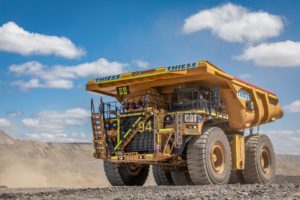
Are you also partnering with the major OEMs directly on access to early prototypes of battery electric trucks?
MW: As with many of the major miners, yes, we are working with OEMs on access to early prototype battery trucks, this includes Caterpillar’s Early Learner Program and Komatsu’s Power Agnostic truck alliance. But this is unlikely to be the only solution for us as a mining services provider. We are also looking at putting our resources into working with industrial partner companies on a whole of life battery solution for customers. MACA is already partnering with AVL Engineering, Mitsui and Forsee Power to potentially create a modular style of battery, which means that we will be able to change the battery chemistry depending on the infrastructure that is available at our client sites. This agnostic approach to battery chemistry as well as being able to utilise a flexible energy mix, potentially including hydrogen/ammonia-based, solar, natural gas and wind power but also other clean power sources, may be crucial to succeeding in the new mining market. It is also worth remembering that there is also going to be a big interplay between your battery mining trucks and your fleet management, energy management and autonomy systems. No-one has that in place yet but some major miners including Fortescue are working on it. As an example, we are working with them at Iron Bridge with a mining services agreement using Liebherr trucks, and this mine will be one of the first operations to use some of this zero emissions technology, with a vision to supply green magnetite iron ore to produce green steel. It’s important to know not only when the truck needs to recharge, but the optimal charge level to recharge the truck, based on the mining circuit’s haul cycles. We are looking at partnerships to enable this. We are also looking at emissions reduction opportunities, working closely with clients on how we can achieve a true mine of the future.
Is there a place for trolley assist and IPCC in your mine of the future vision and to what extent are you offering these as options for customers?
MW: Yes, trolley assist haulage systems have a lot of potential and all of the major miners are looking to this, due to the potential to charge battery trucks. The OEMs see it as a faster way to get battery trucks commercially running as they will recharge on the ramp. For Thiess, this wouldn’t be viable under a short term contract. That said, most of our contracts are long term – at least eight years and some more than 20 years. For us, this system would mean taking a partnership approach with the client as part of helping them position themselves at the forefront of sustainable mining. And as the largest surface mining services provider, we need to be able to offer trolley systems as an option, working with the OEMs and other partners.
Autonomous drills operating at Lake Vermont being monitored from a remote operations centre
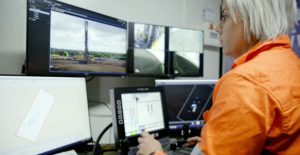
The application of IPCC (in pit crushing and conveying) as well also has potential. We had a JV with RWE, called Thiess RWE (TRWE), which was formed in 2013 to provide to provide a full suite of in-house design, engineering, operation and maintenance services for continuous mining and IPCC. We did look at some projects and undertook major studies as part of that. While the JV lies dormant, these projects mean that we do now have significant in-house IPCC expertise, plus we still maintain a relationship with RWE. We very much see IPCC as playing its part in the mine of the future and are looking at establishing other partnerships as well in that regard. And we have our own direct IPCC experience in the Latrobe Valley in Victoria in the lignite mines, where we are the major shareholder in a JV, RTL Mining and Earthworks – those mines use continuous mining methods including bucketwheel excavators, though of course they will gradually wind down in the next 20 or so years. By way of example, we pioneered the dozer push mining method that replaced bucketwheel mining at the Yallourn operation. A fleet of highly modified Caterpillar D11 Dozers pushes coal to high volume throughput feeder breakers, which feed coal onto a face conveyor system. Since purchasing the State Electricity Commission’s mobile plant fleet in 1992, RTL has also been providing mobile plant hire and earthworks to AGL’s Loy Yang Mine. Lastly, the fact that the Latrobe operations are winding down also means there is huge rehabilitation potential there for Thiess Rehabilitation, and we have the large installed base of dozers, ADTs and rigid trucks to be able to meet that demand in due course. And of course, we have a great team of people in the Latrobe Valley.
You also have a growing underground mining business – can you give an example of your activities there?
MW: Our underground business is small by comparison to others however we do have great capability. The best example we have currently is in Mongolia, through our longstanding majority owned Joint Venture, Thiess Khishig Arvin (TKAJV). We has secured additional underground works as part of a contract extension at the Rio Tinto-operated Oyu Tolgoi copper mine in Mongolia’s southern Gobi Desert. Following the twin 6.5km underground declines, the Thiess Joint Venture will now construct the concrete conveyor decline road, conveyor hangers, and change house, as part of the ongoing development at the mine. The works follow the team’s safe and successful delivery of the twin decline tunnels, connecting the C2S conveyor to surface tunnel to the existing underground mine.











